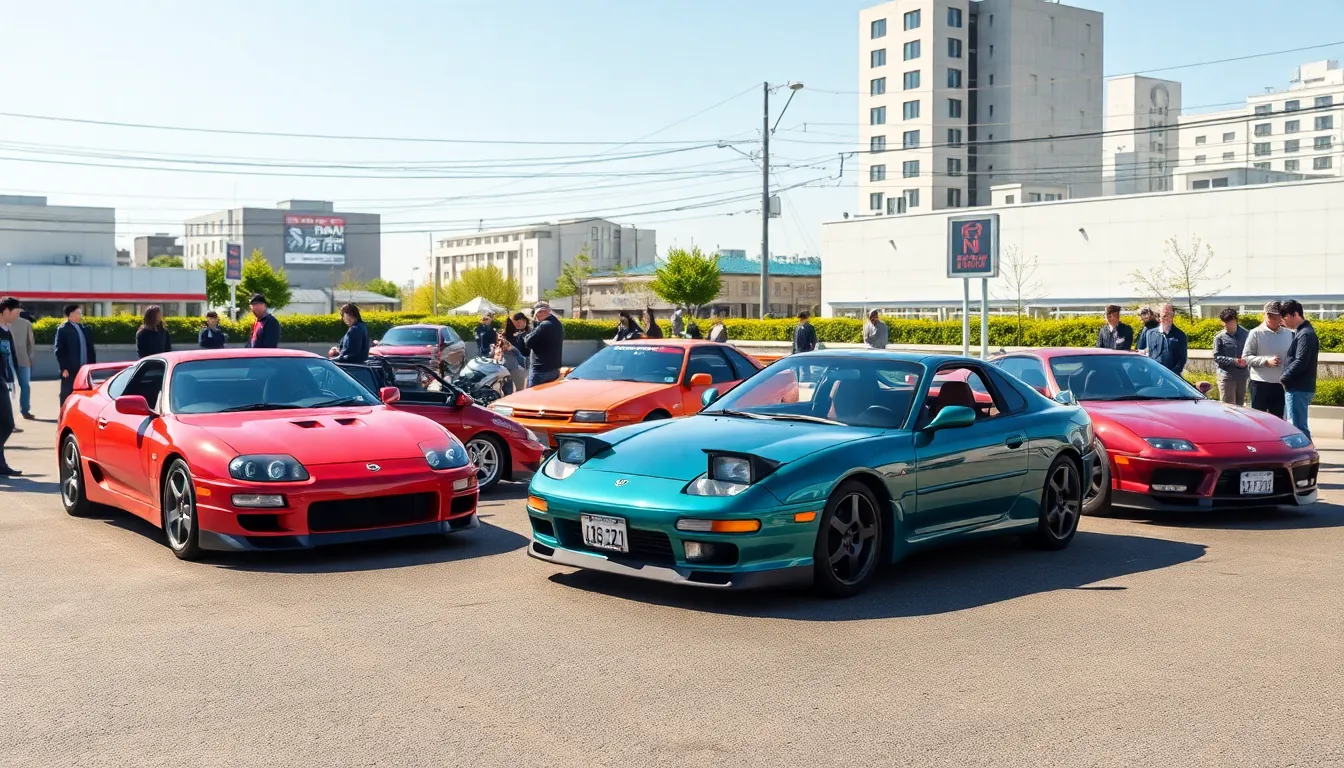The 1990s marked the golden era of Japanese automotive engineering when manufacturers like Toyota, Honda, Nissan, and Mazda unleashed some of the most legendary performance cars ever built. We’re talking about an incredible decade that gave birth to icons like the Toyota Supra, Nissan Skyline GT-R, Honda NSX, and Mazda RX-7 – machines that continue to dominate car enthusiast conversations today.
These weren’t just ordinary vehicles; they represented Japan’s automotive philosophy at its finest. Japanese engineers combined cutting-edge technology with meticulous craftsmanship creating cars that delivered exceptional performance while maintaining remarkable reliability. From turbocharged powerhouses to naturally aspirated masterpieces each model showcased innovative engineering that often surpassed their European and American counterparts.
Today’s collectors and enthusiasts recognize 90s Japanese cars as some of the most desirable vehicles on the market. We’ll explore why these automotive legends continue to appreciate in value and capture hearts worldwide decades after they first hit the streets.
The Golden Era of Japanese Performance: Why the 90s Defined Japan’s Automotive Legacy
Japan’s automotive industry reached unprecedented heights during the 1990s, establishing a performance legacy that continues to influence car culture worldwide. Economic prosperity fueled massive research and development budgets, allowing manufacturers to push technological boundaries without the constraints that would define later decades.
Technological Innovation Peak
Advanced engineering capabilities emerged from Japan’s bubble economy, creating vehicles that combined cutting edge technology with exceptional build quality. Manufacturers invested heavily in turbocharging systems, all wheel drive technologies, and lightweight materials that transformed performance car standards. Variable valve timing systems like Honda’s VTEC and Toyota’s VVT i revolutionized engine efficiency and power delivery across multiple RPM ranges.
Racing Heritage Integration
Motorsport success directly influenced production car development during this era, with manufacturers transferring race proven technologies to street legal vehicles. We saw Formula 1 innovations appear in the Honda NSX’s aluminum construction and advanced aerodynamics. Group A touring car championships pushed the Nissan Skyline GT R’s ATTESA all wheel drive system and sophisticated electronic stability controls. Rally racing developments enhanced the Subaru Impreza WRX’s boxer engine layout and symmetrical drivetrain configuration.
Market Competition Catalyst
Fierce rivalry between Toyota, Nissan, Honda, Mazda, and Mitsubishi created an arms race of performance innovation that benefited enthusiasts worldwide. Each manufacturer developed signature technologies to differentiate their offerings from competitors’ models. Twin turbo systems became standard on flagship sports cars, while naturally aspirated engines reached exact output levels exceeding 100 horsepower per liter. Manufacturing quality standards reached levels that ensured these vehicles would remain reliable and desirable decades later.
Cultural Impact Foundation
Japanese performance cars from the 90s established automotive subcultures that persist today, influencing everything from video games to movie franchises. Street racing scenes embraced models like the Mitsubishi 3000GT VR 4 and Toyota Celica GT Four for their tunability and performance potential. Import racing culture grew around these vehicles, creating aftermarket industries that continue generating revenue and innovation. Collector markets now value pristine examples of these cars at prices exceeding their original retail costs, confirming their lasting cultural significance.
Legendary Supercars That Put Japan on the Global Map
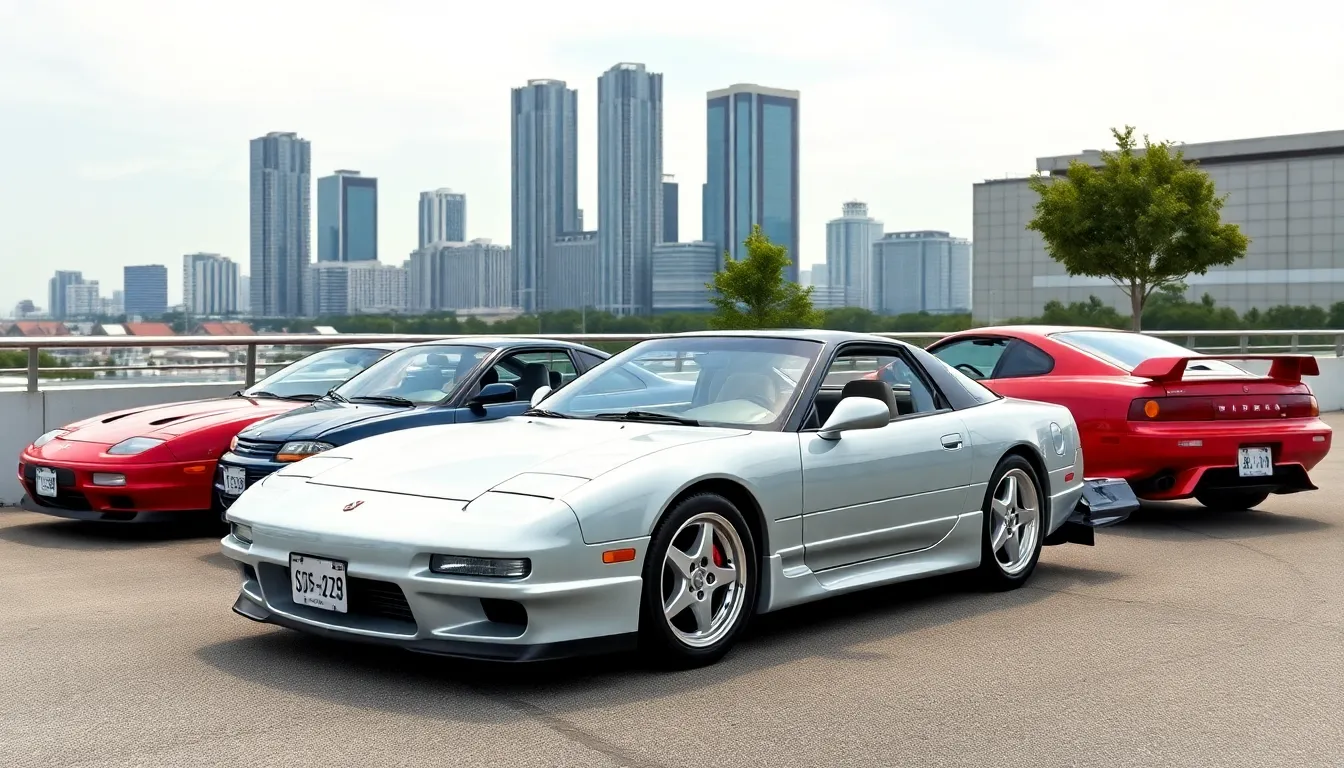
Japan’s supercar revolution reached its pinnacle with four groundbreaking models that redefined automotive excellence. These machines challenged European dominance and established new benchmarks for performance, innovation, and reliability.
Honda NSX: The Everyday Supercar Revolution
Honda NSX transformed the supercar industry by delivering exotic performance without the temperamental nature of its European rivals. Launched in 1990, the NSX featured an all-aluminum monocoque chassis that weighed just 3,010 pounds while providing exceptional rigidity.
Power came from a naturally aspirated 3.0-liter V6 engine producing 270 horsepower in its initial form, later upgraded to 290 horsepower with the 3.2-liter variant in 1997. The mid-mounted VTEC engine delivered smooth acceleration from 0-60 mph in 5.7 seconds.
Legendary Formula 1 driver Ayrton Senna helped develop the NSX, providing crucial feedback that refined the car’s handling characteristics. His input resulted in a supercar that offered precise steering, balanced weight distribution, and predictable behavior at the limit.
Revolutionary manufacturing techniques included Honda’s use of titanium connecting rods and an aluminum space frame construction that was unprecedented in the automotive industry. These innovations reduced weight while maintaining structural integrity.
Mazda RX-7: Rotary Engine Perfection
Mazda RX-7 FD generation represented the ultimate evolution of rotary engine technology, debuting in 1992 with a twin-turbocharged 13B-REW engine. This 1.3-liter rotary powerplant produced 255 horsepower while weighing significantly less than conventional piston engines.
Sequential twin-turbo system eliminated traditional turbo lag by using a smaller primary turbocharger for low-end response and a larger secondary turbo for high-rpm power. This configuration delivered seamless power delivery across the entire rpm range.
Perfect 50/50 weight distribution resulted from the rotary engine’s compact size and central placement, creating exceptional handling dynamics. The RX-7 achieved 0-60 mph acceleration in just 5.3 seconds with a top speed of 155 mph.
Iconic pop-up headlights and flowing bodylines made the FD generation instantly recognizable, while advanced features included four-wheel steering and adaptive suspension systems on higher trim levels.
Mitsubishi 3000GT VR-4: All-Wheel Drive Innovation
Mitsubishi 3000GT VR-4 pioneered advanced all-wheel drive technology in the supercar segment, featuring an active transfer case that could vary torque distribution between front and rear axles. This system provided exceptional traction and stability in all weather conditions.
Twin-turbocharged 3.0-liter V6 engine generated 300 horsepower and 307 lb-ft of torque, making it one of the most powerful Japanese cars of its era. The sophisticated engine management system included variable intake geometry and electronic boost control.
Four-wheel steering system enhanced maneuverability at low speeds and improved stability during high-speed cornering. Electronic suspension adjustment allowed drivers to select from three different damping settings to match driving conditions.
Advanced aerodynamics package included an active rear spoiler that automatically deployed at speeds above 50 mph, reducing lift and improving high-speed stability. Pop-up headlights and distinctive side vents created a dramatic appearance that matched the car’s performance capabilities.
Nissan 300ZX: Turbo Technology Mastery
Nissan 300ZX Twin Turbo showcased advanced forced induction technology with its VG30DETT engine producing 300 horsepower from a 3.0-liter V6. The sophisticated turbocharging system used variable geometry turbos and electronic boost control for optimal performance.
Revolutionary Super HICAS four-wheel steering provided enhanced handling by turning the rear wheels in the same direction as the front wheels at high speeds and in the opposite direction at low speeds. This system improved both stability and agility.
Advanced electronic systems included traction control, adjustable suspension, and a sophisticated engine management system that monitored dozens of parameters. These technologies were groundbreaking for their time and influenced future supercar development.
Striking design elements featured a low, wedge-shaped profile with T-top removable roof panels and distinctive twin-turbo badging. The interior included digital instrumentation and premium materials that rivaled European luxury sports cars.
Iconic Sports Cars That Became Tuning Culture Legends
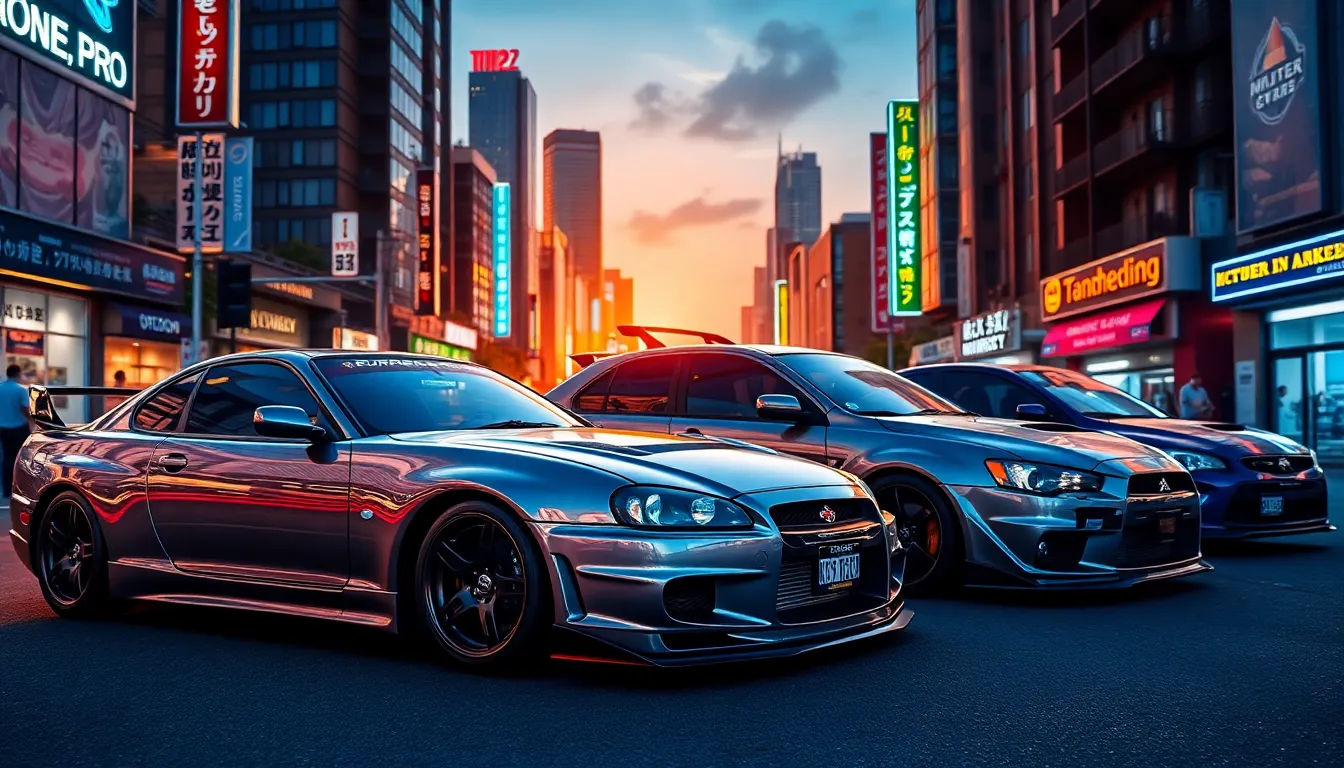
These legendary Japanese sports cars transcended their factory specifications to become the foundation of global tuning culture. Each model offered incredible potential for modification that continues to inspire enthusiasts worldwide.
Toyota Supra: The Ultimate Tuner Platform
Toyota’s fourth generation Supra established itself as the most versatile tuning platform ever created. Built around the legendary 2JZ-GTE twin turbo engine, this powerhouse delivered 320 horsepower from the factory while hiding enormous potential beneath the hood.
Modifying enthusiasts discovered the 2JZ engine could handle astronomical power levels without major internal modifications. Stock internals regularly supported 600-800 horsepower with proper tuning, while fully built engines achieved 1,000+ horsepower figures that seemed impossible from a production car.
Underground racing scenes embraced the Supra’s straight line dominance throughout the late 1990s and early 2000s. Its appearance in “The Fast and the Furious” franchise catapulted the model into mainstream culture, creating a devoted following that persists today.
Aftermarket companies developed extensive modification catalogs specifically for the Supra platform. Popular upgrades included single turbo conversions, standalone engine management systems, and comprehensive suspension packages that transformed handling characteristics.
Nissan Skyline GT-R: Godzilla’s Reign Begins
Nissan’s R32 GT-R earned its “Godzilla” nickname through devastating performance that destroyed competition on racetracks worldwide. The RB26DETT twin turbo inline six engine produced 276 horsepower officially, though actual output measured closer to 320 horsepower.
Advanced all wheel drive technology gave the GT-R unprecedented traction advantages over rear wheel drive competitors. The ATTESA E-TS system could transfer up to 50% of engine power to the front wheels, enabling incredible acceleration and cornering capabilities.
Japanese tuning houses like HKS, Spoon Sports, and Top Secret developed legendary GT-R builds that achieved supercar performance levels. These companies pioneered modification techniques that became standard practice across the global tuning community.
Regulatory restrictions initially limited GT-R availability to the Japanese domestic market, creating mystique around the model. Gray market imports eventually brought these machines to international enthusiasts who recognized their exceptional potential.
Subaru Impreza WRX STI: Rally-Bred Performance
Subaru’s Industry Rally Championship success directly influenced the development of street legal WRX STI models. The company transferred racing technology like the EJ20 turbocharged boxer engine and symmetrical all wheel drive system into production vehicles.
Distinctive hood scoop design became an iconic visual element that announced the car’s performance intentions. The functional intercooler scoop fed cool air to the top mounted heat exchanger, maintaining consistent power delivery under demanding conditions.
Tuning potential of the EJ20 engine attracted enthusiasts seeking reliable all wheel drive performance. Popular modifications included larger turbochargers, upgraded fuel systems, and strengthened internals that supported important power increases.
Motorsport heritage connected every WRX STI to Subaru’s rally racing legacy through Richard Burns, Petter Solberg, and Colin McRae. This racing pedigree validated the platform’s performance capabilities and inspired countless enthusiasts to pursue their own builds.
Mitsubishi Lancer Evolution: Street Legal Race Car
Mitsubishi developed the Lancer Evolution specifically to homologate their Industry Rally Championship entries. Each generation incorporated lessons learned from international competition, resulting in increasingly sophisticated performance packages.
The 4G63 turbocharged engine powered early Evolution models with exceptional reliability and modification potential. This iron block powerplant could handle substantial power increases with basic bolt on modifications, making it extremely popular among tuners.
Active Yaw Control differentiated later Evolution models through advanced torque vectoring technology. The system actively transferred power between rear wheels during cornering, providing unprecedented handling precision that rivaled dedicated sports cars.
Tuning companies created extensive aftermarket support for Evolution platforms across all generations. Brands like AMS Performance, Buschur Racing, and English Racing developed complete performance packages that transformed these cars into track weapons.
Affordable Enthusiast Cars That Started the Import Scene

While supercars captured headlines, affordable Japanese models created the foundation of America’s import tuning culture. These accessible performance cars transformed weekend warriors into lifelong enthusiasts.
Honda Civic Si: The Gateway Drug to Modification
Honda Civic Si models delivered sports car thrills at economy car prices throughout the 1990s. We witnessed countless enthusiasts begin their modification journeys with these affordable platforms, thanks to their reliable VTEC engines and lightweight construction. The 1992-1995 hatchback Si featured the legendary B16A engine producing 160 horsepower, while maintaining exceptional fuel economy for daily driving duties.
Modification potential made the Civic Si irresistible to budget-conscious tuners seeking maximum performance per dollar. Engine swaps became commonplace, with enthusiasts installing more powerful B-series motors like the B18C from the Integra Type R. Suspension upgrades, intake modifications, and exhaust systems provided immediate performance gains without very costly.
Racing success elevated the Civic Si from economy car to legitimate performance machine. SCCA autocross events and grassroots road racing series showcased the platform’s capabilities, inspiring thousands to purchase their own Si models. The combination of affordability, reliability, and modification potential created a perfect storm for import tuning culture.
Acura Integra Type R: Front-Wheel Drive Perfection
Acura Integra Type R arrived in 1997 as the ultimate expression of front-wheel drive performance engineering. We consider this model the pinnacle of Honda’s naturally aspirated technology, featuring the high-revving B18C5 engine that screamed to 8,400 RPM while producing 195 horsepower. Weight reduction measures included stripped interiors, no air conditioning, and lightweight wheels that demonstrated Honda’s commitment to pure performance.
Track-focused engineering separated the Type R from ordinary performance cars of its era. Close-ratio transmissions, limited-slip differentials, and precisely tuned suspension components created a driving experience that rivaled more expensive European alternatives. The distinctive Championship White paint and massive rear wing announced the car’s serious intentions to anyone within visual range.
Collector status transformed the Type R from affordable performance car to investment-grade classic. Original examples now command prices exceeding $40,000, representing more than double their original MSRP of $22,900. This appreciation reflects the model’s significance in establishing Japanese manufacturers as legitimate performance car builders rather than economy-focused companies.
Toyota Corolla AE86: Drift King Origins
Toyota Corolla AE86 models became legendary even though producing only 112 horsepower from their naturally aspirated 4A-GE engines. We recognize this rear-wheel drive platform as the foundation of modern drifting culture, thanks to its perfect weight distribution and predictable handling characteristics. The lightweight construction and responsive chassis made the AE86 ideal for spirited driving on mountain roads throughout Japan.
Drifting culture elevated the humble Corolla to icon status within import communities worldwide. Japanese street racers discovered the AE86’s natural tendency to oversteer, leading to the development of controlled sliding techniques that became known as drifting. This driving style spread globally through video games like Initial D and underground racing videos.
Aftermarket support transformed basic AE86 models into serious performance machines. Engine swaps ranging from turbocharged 4A-GZE motors to modern SR20DET and LS V8 conversions became standard modifications. Suspension manufacturers developed coilover systems specifically for drifting applications, while body kit companies created aggressive aero packages that enhanced both appearance and performance.
Mazda Miata: Roadster Revival
Mazda Miata single-handedly revived the affordable roadster market when it debuted in 1989. We credit this model with proving that lightweight, rear-wheel drive sports cars could succeed in an era dominated by heavy, complex performance machines. The simple formula of minimal weight, perfect balance, and open-top driving created an captivating experience that expensive supercars couldn’t match.
Racing heritage established the Miata as a legitimate performance platform beyond its recreational image. SCCA Spec Miata became the most popular racing class in America, with over 3,000 cars competing nationwide. Professional racing series including Industry Challenge and IMSA featured Miata-based race cars that demonstrated the platform’s competitive potential.
Modification culture embraced the Miata’s potential for both street and track applications. Turbocharger kits, engine swaps, and suspension upgrades allowed enthusiasts to dramatically increase performance while maintaining the car’s fundamental character. The strong aftermarket support and active community made Miata ownership accessible to enthusiasts with varying budgets and skill levels.
Revolutionary Technology That Changed Automotive History
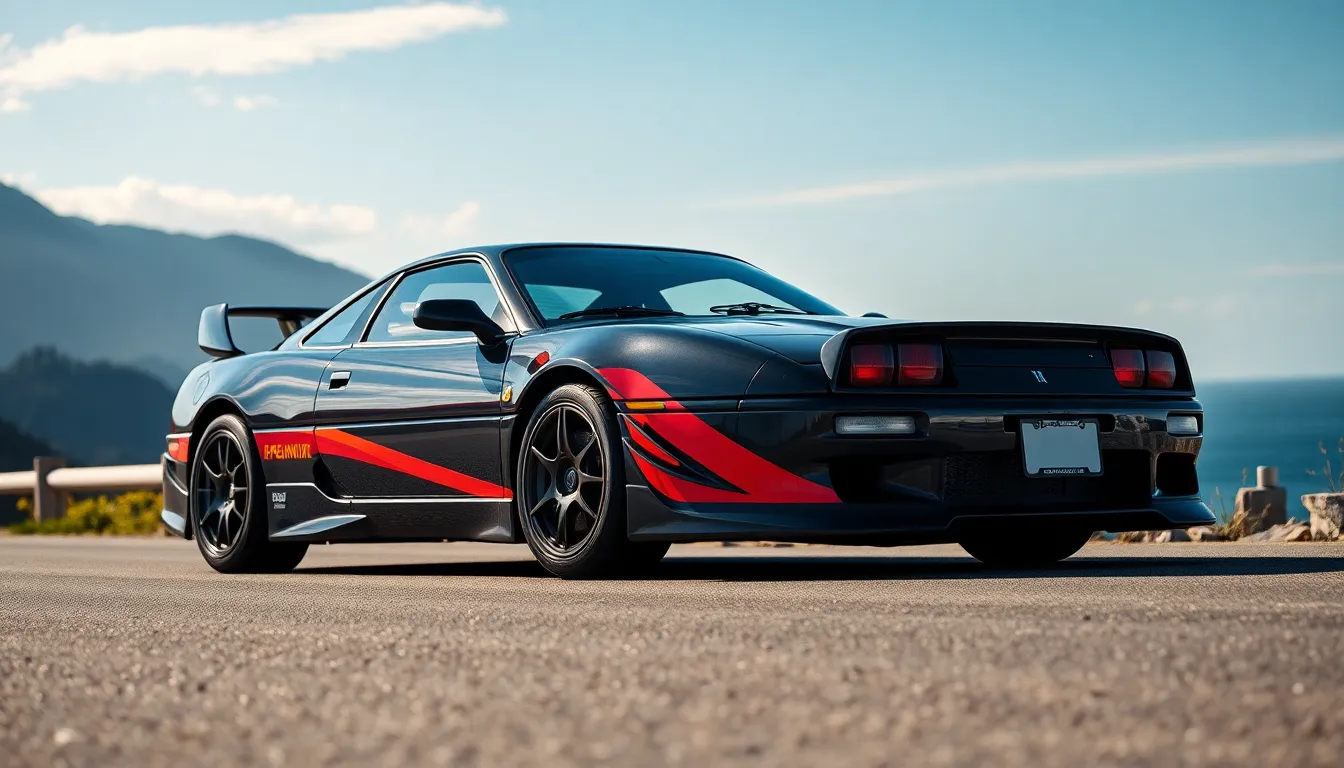
Japan’s 90s automotive engineers didn’t just build cars—they rewrote the rules of performance engineering. These innovations became the foundation for modern automotive technology.
VTEC and Variable Valve Timing Systems
VTEC technology revolutionized how engines breathed, delivering both efficiency and power in a single system. Honda’s Variable Valve Timing and Lift Electronic Control allowed engines to switch between two distinct cam profiles, optimizing performance for both daily driving and high-RPM acceleration. We saw this breakthrough first in the 1989 Honda CRX Si, where the B16A engine produced an impressive 160 horsepower from just 1.6 liters.
Toyota answered with their VVT-i (Variable Valve Timing-intelligent) system, which provided continuous adjustment rather than Honda’s two-stage approach. This technology appeared in engines like the legendary 2JZ-GTE, allowing for smoother power delivery and better fuel economy. Nissan developed their own version called VTC (Variable Timing Control), while Mazda implemented variable valve timing in their rotary engines through different intake timing mechanisms.
Performance gains from these systems were substantial, with VTEC engines achieving power outputs of 100+ horsepower per liter naturally aspirated. Racing applications proved the technology’s worth, as VTEC-equipped cars dominated touring car championships worldwide. Today’s modern engines still use principles pioneered by these 90s Japanese innovations.
Advanced All-Wheel Drive Systems
All-wheel drive technology reached new sophistication levels in 90s Japanese sports cars, transforming traction and handling capabilities. Nissan’s ATTESA E-TS system in the R32 Skyline GT-R used electronic controls to distribute power between front and rear axles, creating what enthusiasts called “four-wheel drift” capability. We witnessed this system’s effectiveness in Group A racing, where the GT-R earned its “Godzilla” nickname.
Mitsubishi’s Super All-Wheel Control (S-AWC) in the 3000GT VR-4 combined all-wheel drive with active aerodynamics and four-wheel steering. This comprehensive approach to vehicle dynamics management was unprecedented in production cars. Subaru’s symmetrical AWD layout in the Impreza provided inherent balance and became the template for modern performance AWD systems.
Electronic differentials and torque vectoring capabilities allowed these cars to corner at speeds that challenged traditional rear-wheel drive supercars. Rally racing success validated these technologies, with Subaru and Mitsubishi dominating Industry Rally Championship competitions throughout the decade. Modern supercars now consider advanced AWD systems essential for achieving maximum performance.
Turbocharging and Twin-Turbo Configurations
Turbocharging technology advanced dramatically during the 90s, with Japanese engineers perfecting both single and twin-turbo setups. Toyota’s 2JZ-GTE twin-turbo system used sequential turbochargers to eliminate lag while providing massive power potential, supporting 1000+ horsepower with internal modifications. We experienced this breakthrough in the Supra, where smooth power delivery combined with incredible tunability.
Nissan’s RB26DETT engine featured twin ceramic turbochargers that spooled quickly and operated efficiently across the rev range. This configuration produced 280 horsepower (officially limited) but could easily support much more power with simple modifications. Electronic boost control systems allowed precise wastegate management and consistent performance across different driving conditions.
Mazda took a different approach with their twin-turbo 13B rotary engine in the RX-7, using sequential turbocharging to match the rotary’s unique powerband characteristics. Intercooling technology improved significantly, with top-mount and front-mount configurations becoming standard on performance models. These innovations established turbocharging as the preferred method for extracting maximum power from smaller displacement engines.
Lightweight Construction and Aerodynamics
Lightweight materials and advanced aerodynamics became hallmarks of 90s Japanese sports car engineering. Honda’s NSX pioneered aluminum space frame construction in production cars, achieving a curb weight of just 3,010 pounds while maintaining exceptional rigidity. We observed how this aluminum intensive design influenced handling precision and acceleration performance.
Carbon fiber components appeared in limited production models like the Honda NSX Type-R and Mazda RX-7 Spirit R, reducing weight while adding structural strength. Active aerodynamics reached production reality in the Mitsubishi 3000GT VR-4, featuring automatic front and rear spoilers that adjusted based on speed and driving conditions. These systems improved high-speed stability while maintaining clean aerodynamics at lower speeds.
Wind tunnel development became crucial for achieving optimal aerodynamic efficiency, with cars like the Toyota Supra and Nissan 300ZX featuring carefully sculpted bodywork that managed airflow around wheels and underbody components. Weight distribution optimization through strategic material placement created balanced handling characteristics that rivaled purpose-built sports cars. Modern automotive engineering still references these 90s innovations when developing lightweight, aerodynamically efficient performance vehicles.
Cultural Impact and Global Influence of Japan 90s Cars
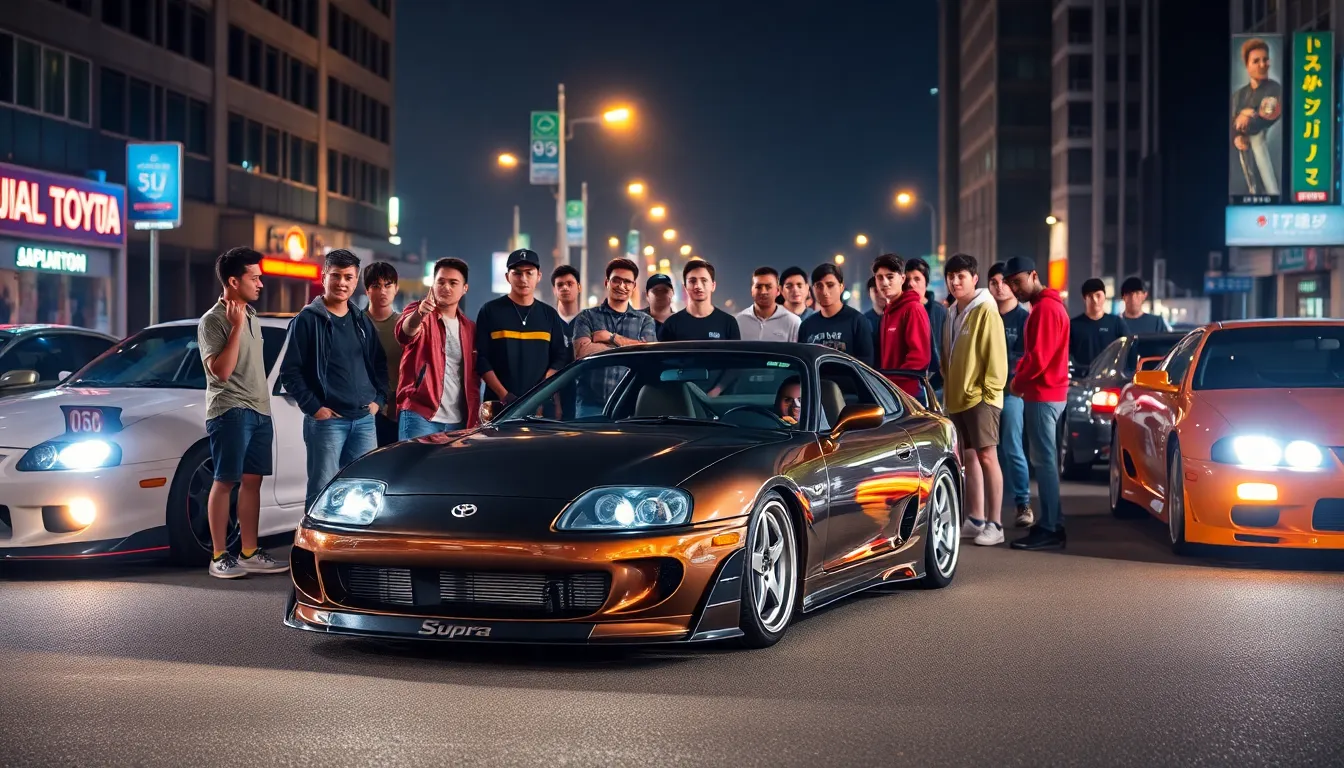
Japan’s 90s automotive legacy transformed from engineering excellence into a global cultural phenomenon that continues shaping automotive enthusiasts worldwide. These iconic vehicles transcended traditional car culture boundaries to become symbols of performance, style, and rebellious spirit.
Fast and Furious Movie Franchise Influence
Films featuring 90s Japanese cars catapulted these vehicles into mainstream pop culture consciousness. The original Fast and Furious movie in 2001 showcased the Toyota Supra, Honda Civic, and Mitsubishi Eclipse as heroes of street racing culture. Paul Walker’s character driving a modified Supra created instant demand for these cars among younger generations who’d never experienced 90s tuning culture firsthand.
Subsequent sequels elevated more Japanese models to celebrity status. The Nissan Skyline GT-R appeared in later films as the ultimate performance machine, while the Honda S2000 and Mazda RX-7 gained recognition as desirable sports cars. Movie appearances caused dramatic price increases for these vehicles, with clean examples becoming increasingly rare and expensive.
Hollywood’s portrayal established visual aesthetics that defined import car culture. Neon underglow lighting, aggressive body kits, and custom paint schemes became standard modifications inspired by movie cars. These cinematic representations influenced real-industry tuning trends for decades after the films’ releases.
Import Racing Scene Development
Underground racing communities formed around Japanese performance cars in major metropolitan areas. Cities like Los Angeles, New York, and Miami became hotbeds for street racing culture centered on modified Supras, Skylines, and other 90s imports. Drag strips and road courses hosted events specifically for Japanese cars, creating organized venues for enthusiasts to showcase their builds.
Professional racing series embraced 90s Japanese platforms for competitive motorsports. Time Attack competitions, drifting championships, and SCCA road racing classes featured heavily modified versions of these vehicles. Organizations like Formula Drift built entire racing series around cars originally designed in Japan during the 1990s.
International racing events spread Japanese car culture globally. European tuning scenes adopted 90s Japanese cars as preferred platforms for circuit racing and drag racing. Australian import culture thrived around Skylines and other models that were never officially sold in North America, creating unique regional variations of tuning styles.
Tuning Culture and Aftermarket Industry Growth
Aftermarket companies developed entire product lines specifically for 90s Japanese cars. Manufacturers like HKS, Spoon Sports, and Mugen created performance parts that enhanced power, handling, and aesthetics. American companies including AEM, Skunk2, and GReddy established themselves by producing high-quality modifications for these platforms.
Engine swap culture exploded around interchangeable Japanese powerplants. The 2JZ engine from the Supra became the gold standard for high-horsepower builds across multiple chassis types. Honda’s B-series and K-series engines found their way into countless vehicles, creating mix-and-match combinations that maximized performance potential.
Online communities facilitated knowledge sharing and parts trading worldwide. Forums dedicated to exact models like SupraForums and NASIOC connected enthusiasts globally, sharing technical information and modification guides. These digital communities preserved tuning knowledge and fostered international relationships between car builders.
Video Game Appearances and Pop Culture Status
Racing video games immortalized 90s Japanese cars for multiple generations of players. Gran Turismo featured detailed recreations of the Supra, Skyline GT-R, and NSX that introduced millions to these vehicles’ performance capabilities. Need for Speed Underground showcased tuning culture and street racing aesthetics inspired by real-industry import scenes.
Gaming franchises created lasting emotional connections between players and exact car models. Many enthusiasts purchased their first 90s Japanese car because they’d driven virtual versions in video games. The Nissan Silvia S13, Toyota AE86, and Honda Integra gained cult followings partly through their prominence in racing game lineups.
Pop culture references extended beyond automotive media into mainstream entertainment. Music videos, television shows, and social media content regularly featured 90s Japanese cars as symbols of performance and style. These appearances maintained cultural relevance for vehicles that were decades old, ensuring continued demand among younger demographics who discovered them through digital media.
Market Values and Collectibility Today
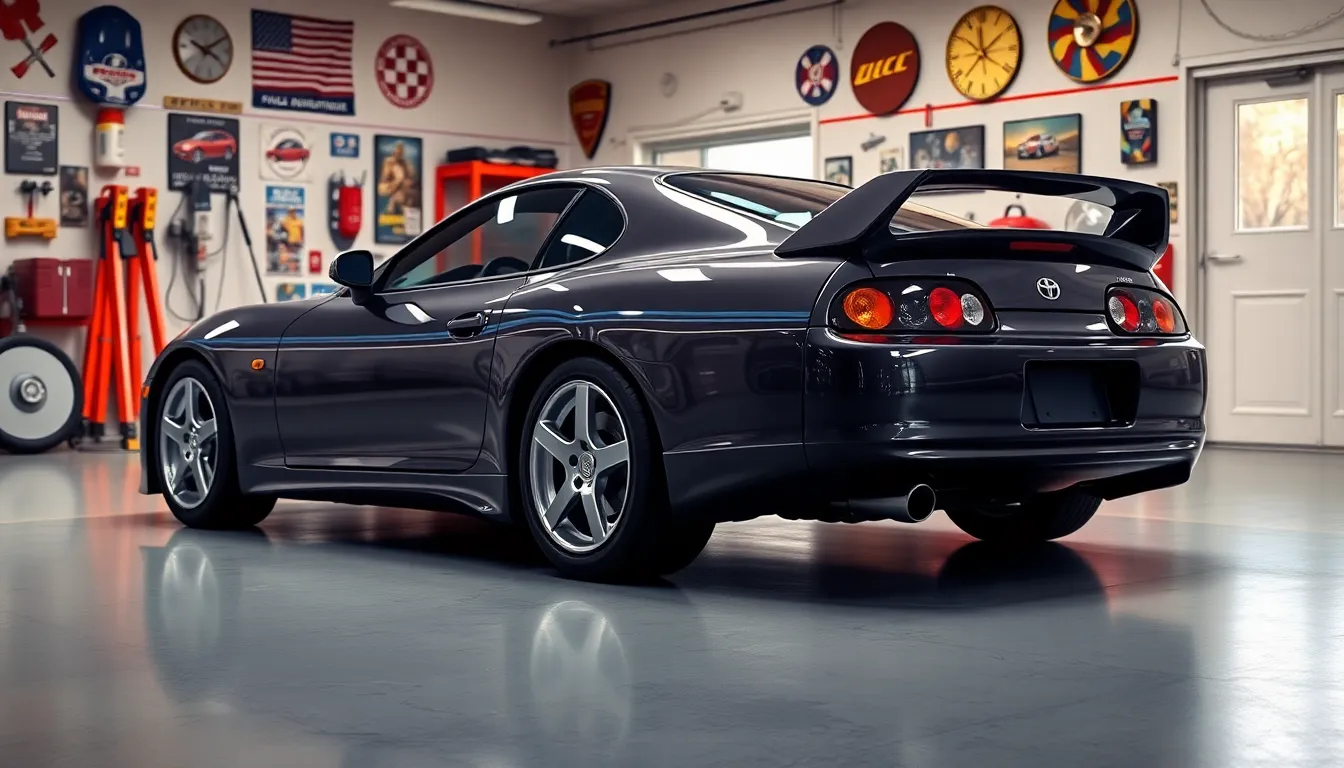
We’re witnessing unprecedented appreciation in 90s Japanese sports car values as collectors recognize their historical significance. These vehicles have transformed from affordable enthusiast cars into serious investment opportunities that rival traditional European exotics.
Appreciation Rates and Investment Potential
Toyota Supra Turbo models have experienced the most dramatic value increases, with pristine examples selling for $150,000-$200,000 compared to their original $40,000 MSRP. Manual transmission Supras command premium prices, often appreciating 15-20% annually over the past five years.
Nissan Skyline GT-R R34 values have skyrocketed since becoming legal for US import in 2024, with clean examples reaching $300,000-$500,000. R32 and R33 generations trade between $80,000-$180,000, showing consistent 10-12% annual appreciation.
Honda NSX Type R models represent the pinnacle of collectibility, with examples selling for $400,000-$600,000 at auction. Standard NSX models have tripled in value, trading between $120,000-$180,000 depending on year and condition.
Mazda RX-7 FD prices have steadily climbed, with low-mileage examples commanding $60,000-$120,000. Single-owner, unmodified examples show the strongest appreciation potential among rotary enthusiasts.
Rarity Factors and Production Numbers
Limited production runs significantly impact current market values across all 90s Japanese performance models. Honda produced only 290 NSX Type R units globally, making them extraordinarily rare compared to standard NSX production of 18,685 units.
Regional exclusivity drives demand for models never officially sold in certain markets. Nissan Skyline GT-R models were Japan-exclusive until recent import eligibility, creating pent-up demand in Western markets.
Special editions command substantial premiums over standard variants. Toyota Supra RZ models with the twin-turbo 2JZ-GTE engine number approximately 11,000 units globally, while naturally aspirated versions were more common.
Color combinations influence collectibility significantly. Mazda RX-7 models in Montego Blue Mica or Vintage Red represent less than 5% of total production, creating additional scarcity value.
| Model | Total Production | Current Value Range |
|---|---|---|
| Honda NSX Type R | 290 units | $400,000-$600,000 |
| Nissan GT-R R34 V-Spec II Nür | 1,003 units | $400,000-$500,000 |
| Toyota Supra RZ Twin Turbo | ~11,000 units | $150,000-$200,000 |
| Mazda RX-7 Type R Bathurst | 100 units | $180,000-$250,000 |
Condition and Modification Impact on Value
Original, unmodified examples command the highest prices in today’s collector market. We’ve observed that bone-stock Supra Turbos sell for 40-60% more than modified examples with similar mileage.
Documentation and service records play crucial roles in value determination. Cars with complete maintenance histories from authorized dealers typically sell for 20-25% premiums over examples with incomplete records.
Modification quality significantly affects market perception among collectors. Professional builds using period-correct parts maintain better value retention than cars with modern aftermarket components.
Mileage thresholds create distinct value tiers across all models. Examples under 30,000 miles command premium pricing, while high-mileage cars over 100,000 miles trade at important discounts even though mechanical reliability.
Paint and interior condition directly correlates with sale prices. Cars requiring cosmetic restoration often sell for 30-40% less than examples with pristine original finishes, as restoration costs can exceed $15,000-$25,000.
Engine modifications impact value differently across models. Supra owners often accept engine upgrades due to the platform’s tuning reputation, while NSX collectors strongly prefer stock powertrains to maintain authenticity.
Conclusion
Japan’s 90s automotive legacy continues to shape our understanding of what truly exceptional cars can achieve. We’re witnessing these vehicles transition from affordable performance machines into blue-chip collector investments that rival the most prestigious European exotics.
The engineering innovations pioneered during this era didn’t just create memorable cars – they established the foundation for modern automotive technology we see today. From VTEC systems to advanced all-wheel drive platforms these Japanese manufacturers developed answers that the entire industry eventually adopted.
What makes these cars truly special isn’t just their performance capabilities or rising values. It’s how they democratized automotive enthusiasm and created a global community of passionate enthusiasts who continue to celebrate and preserve these mechanical masterpieces for future generations to experience and appreciate.
Frequently Asked Questions
What made 1990s Japanese cars so special?
The 1990s represented a golden age for Japanese automotive engineering, combining advanced technology with exceptional craftsmanship. Economic prosperity allowed manufacturers to invest heavily in research and development, leading to innovations like turbocharging systems, variable valve timing, and advanced all-wheel drive. This resulted in high-performance, reliable vehicles that challenged European dominance and set new industry benchmarks.
Which Japanese cars from the 90s are most iconic?
The most celebrated models include the Toyota Supra, Nissan Skyline GT-R, Honda NSX, and Mazda RX-7. Other notable vehicles are the Mitsubishi 3000GT VR-4, Nissan 300ZX, Subaru Impreza WRX STI, Mitsubishi Lancer Evolution, Honda Civic Si, Acura Integra Type R, Toyota Corolla AE86, and Mazda Miata. These cars defined performance standards and continue to be highly sought after today.
Why are 90s Japanese sports cars so expensive now?
These vehicles have become serious collector investments due to their historical significance, limited production runs, and cultural impact. Pristine examples now sell for prices rivaling European exotics, with some models appreciating dramatically. Factors like original condition, documentation, and unmodified status significantly impact values, with clean examples commanding premium prices in today’s market.
How did Japanese cars influence tuning culture?
Japanese sports cars became the foundation of global tuning culture, particularly models like the Toyota Supra with its legendary 2JZ-GTE engine and the Nissan Skyline GT-R. These vehicles offered exceptional modification potential, reliable platforms for power increases, and affordable entry points into performance driving. This spawned a thriving aftermarket industry and online communities that continue today.
What technologies did 90s Japanese cars pioneer?
Japanese engineers revolutionized automotive technology with VTEC variable valve timing, advanced all-wheel drive systems like Nissan’s ATTESA E-TS, sophisticated turbocharging systems, and lightweight construction using aluminum and carbon fiber. These innovations optimized performance, efficiency, and handling while establishing the foundation for modern automotive technology that influences the industry today.
How did these cars impact popular culture?
90s Japanese cars transcended automotive circles through movies like The Fast and Furious franchise, underground racing scenes, and video games. They became central to street racing culture and motorsports, inspiring a generation of enthusiasts. This cultural phenomenon led to increased demand, dramatic price appreciation, and established these vehicles as icons beyond their engineering excellence.

